
views
X
Trustworthy Source
Cleveland Clinic
Educational website from one of the world's leading hospitals
Go to source
You can diagnose carcinoid syndrome by watching for symptoms. As these symptoms can be similar to other illnesses, you should also undergo further medical testing. If you do have it, your medical team will treat it by fighting the cancer and relieving your symptoms.
Recognizing Symptoms of Carcinoid Syndrome

Watch for flushing on your face and neck. The color of your skin can range from light pink to red or purple, and your skin will feel hot. Some people experience flushing for no reason at all, but it can also be triggered. Skin may be flushed for just a few minutes, but it could also last for hours. Common triggers for flushing include exercise, stress, and alcoholic beverages.

Watch for difficulty breathing, especially if you don’t have asthma. People who have carcinoid syndrome may experience symptoms similar to asthma, even though they don’t have it. This can include wheezing, shortness of breath, and feeling like you can’t breathe. You may experience this during an episode of skin flushing. If this happens, talk to your doctor as soon as possible to rule out possible causes. Seek emergency care if you cannot get your breath.

Notice repeated episodes of diarrhea with no clear cause. Diarrhea is a symptom with a lot of causes. If you do have carcinoid syndrome, it can cause watery, loose stools that are accompanied by abdominal cramps. While it's a common symptom of people with the condition, diarrhea alone does not mean that you have carcinoid syndrome. Talk to your doctor to rule out other causes of diarrhea before settling on carcinoid syndrome.

Look for purplish blood vessels on your nose and upper lip. The blood vessels will look like a spider-web of veins that spreads across the nose and mouth area. If you notice this on your face, you should contact your doctor immediately to get your symptoms checked.

Watch for episodes of rapid heartbeat, along with the other symptoms. Rapid heartbeat may last for short or extended periods of time. While rapid heartbeat alone does not mean you have carcinoid syndrome, it could be an indication of the condition if other symptoms are present. A drop in blood pressure may occur concurrently with changes in your heartbeat.
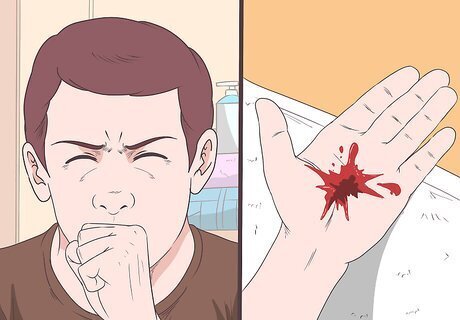
Notice a persistent cough when you haven’t had a respiratory illness. If the tumor is in your lungs, then it may also result in a persistent cough. This is usually only a concern if you haven't had a prior infection. You may also cough up blood. If the condition goes undetected for an extended period of time, you could develop pneumonia.

Watch for unexplained weight gain. Since carcinoid syndrome can lead to extra chemicals in your bloodstream, you may gain weight with no explanation. It’s best to keep track of what you’re eating and how often you exercise so that your doctor can determine if the weight gain could be caused by a medical condition. Remember, weight gain alone does not mean that you have carcinoid syndrome.
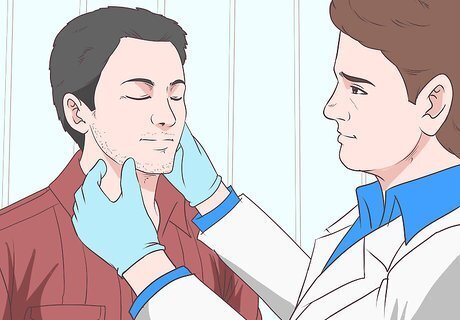
Check for increased facial and body hair. Similar to with weight gain, chemicals secreted into your bloodstream could increase hair growth on your face or body, especially if you’re a woman. If you notice extra hair, talk to your doctor about it. Increased hair growth can have many causes. Your doctor can help find what’s causing your hair growth and identify possible treatments.
Seeking a Medical Opinion

Make an appointment with your doctor. Ask for the earliest appointment possible. Bring a list of your symptoms, including those you don’t think are relevant. You should also let the doctor know if anything in your life has changed recently. Ask your doctor if there are any pre-appointment restrictions you should follow, such as fasting. If you doctor suspects carcinoid syndrome, they’ll refer you to a specialist, such as an oncologist, endocrinologist, or surgeon.
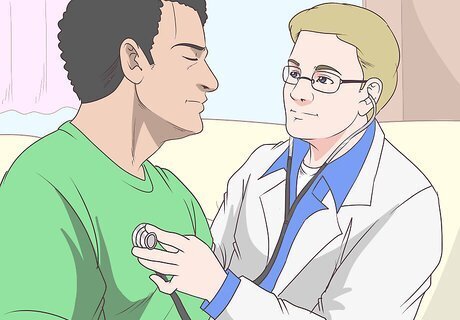
Allow your doctor to perform a physical exam. This is a noninvasive in-office procedure to rule out other causes. Your doctor may look for signs of other conditions, such as undiagnosed asthma. They’ll then decide if more tests are needed to identify the underlying cause.

Do a urine test to look for byproducts of excreted chemicals. The doctor will look for high levels of certain hormones or their remaining broken-down components. This will likely include a 24-hr urine collection. While this test is not at all painful, you may be inconvenienced if the doctor decides to collect your urine over 24 hrs. You will need to urinate in either a special cup or a pan in order to collect your urine. You will then save the urine by placing it in your refrigerator until it's time to return it to the doctor. It's best to do this on a day you'll be home.
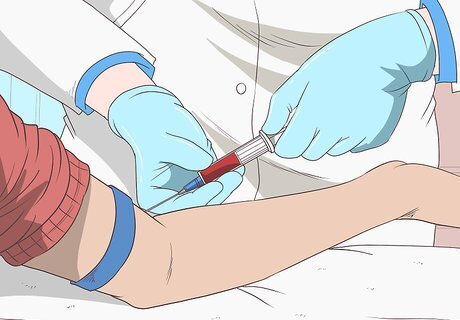
Undergo a blood test to look for chemicals in your bloodstream. Since the tumor is secreting chemicals into your bloodstream, a simple blood test can tell the doctor a lot about your symptoms. The doctor will look for substances like chromogranin A. The blood test will not hurt, but you may feel uncomfortable for a few minutes.

Get an imaging test such as a CT, or MRI if the doctor suspects a tumor. Imaging tests can let the doctor see the tumor and determine if it’s growing. You can get a CT scan or MRI, depending on what your doctor recommends. The doctor may give you a radionuclide before conducting the test so they can look for a tumor. Radionuclide is a small amount of radioactive substance, so it will show up on the CT or MRI. This allows the doctor to check for abnormal areas or masses, which could indicate a tumor. The doctor will start with your abdomen, which is where these tumors are most often located. Your doctor may also order an ultrasound to evaluate the tumor.
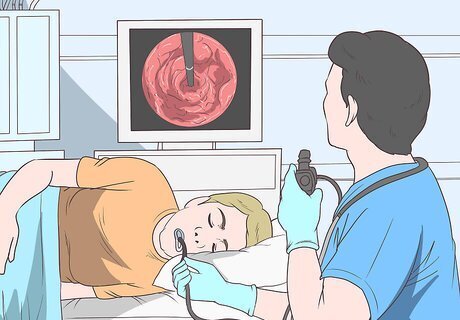
Allow the doctor to use an endoscopic camera to look for the tumor. The doctor will insert the camera down your throat or through your rectum, depending on where they’re looking for the tumor. The endoscopic camera allows the doctor to see and evaluate any tumors that you may have. This test will likely make you uncomfortable, but it will not hurt as you will be under sedation.
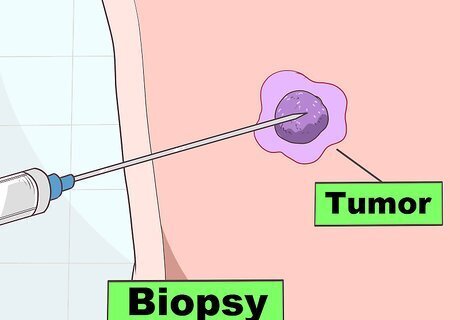
Agree to a biopsy if your doctor thinks it’s necessary. The doctor will likely take the biopsy using a long needle that is inserted into the tumor. They will guide the needle using a CT scan or ultrasound. Your doctor may perform your biopsy either in the hospital or in an outpatient procedure. You will likely feel a lot of discomfort, but the doctor will give you medication to reduce pain. For a lung biopsy, the doctor may decide to send an endoscopic camera down your throat to retrieve the biopsy. A biopsy may also be performed through the outside of the rib cage while you are under general anesthesia. If you are already having surgery near the area, the doctor may take the biopsy then.
Treating Carcinoid Syndrome

Undergo surgery to remove the tumor and affected tissue. Surgery is usually your best treatment option. If the tumor is in your lung, the doctor will remove it as well as a portion of your lung. If it’s in your gastrointestinal tract, the doctor will remove the tumor and the lymph nodes around it. This procedure will be an inpatient procedure. For some individuals, it will relieve the symptoms. However, you may need more treatment if the cancer has spread.

Take octreotide or lanreotide for the symptoms caused by carcinoid syndrome. Your doctor may prescribe this medication to help you cope with symptoms of flushing, diarrhea, and related issues. It works by preventing the tumor from excreting more chemicals. Octreotide or lanreotide is usually given along with other treatments, such as surgery. These medicines are more commonly prescribed when the tumor has spread. In some cases, the doctor will also prescribe alpha-interferon, which helps improve your immune system. Together, these medications can help reduce the size of your tumor.
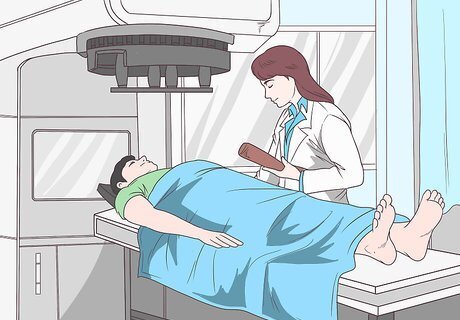
Get chemotherapy or radiation therapy if the cancer has spread. Carcinoid syndrome doesn’t respond well to chemotherapy, but it may be necessary if the cancer has spread. Radiation therapy and immunotherapy may also be used to treat a cancer that is progressing. The doctor will determine if it’s the best treatment option for you. Your doctor may not recommend chemotherapy if you are still feeling unwell.




















Comments
0 comment